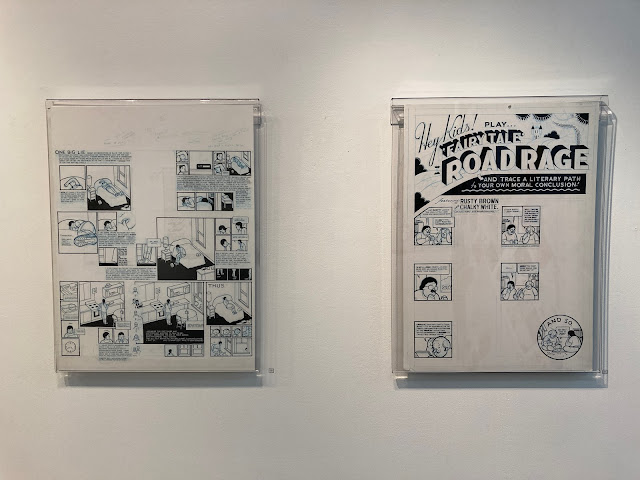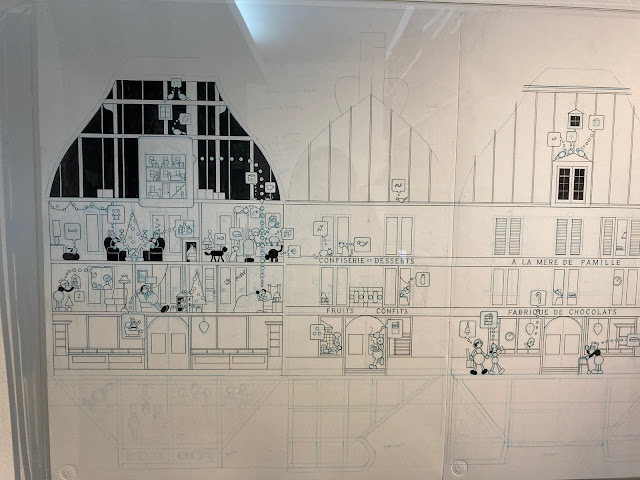by Nick Nguyen
Je les ai vus. Stefano Ricci. Martel BXL, Brussels, Belgium. October 4 - November 22, 2025.
Photos taken by Nick Nguyen except for the exhibition poster (below) from the Martel BXL website.
 |
The 2025 Fall programming at Martel BXL opened with a monograph exhibition devoted to the recent projects of Stefano Ricci, the Italian visual artist whose distinct sensual graphic style resonates across his work in animation, illustration, painting and comics. This show marked the third time that Rina Zavagli's gallery shone its spotlight on Ricci, and Je les ai vus represented his first solo exhibition in Belgium. The English translation of this title is I Saw Them, an assertive nod to the act of seeing that offers several entry points for visitors to engage with the exhibition.
Firstly, it is a reference to the production context of the first grouping of fifteen original pieces displayed in the front section of the gallery. The 2023 reopening of the Cinema Modernissimo in Bologna, Italy after an overlong restoration project was cause for great celebration by cinephiles like Stefano Ricci, inspiring him to offer his artistic support to the Cineteca di Bologna for a poster project that would be known as Li Ho Visti (also translated as I Saw Them). For the complete inaugural season of programming at the Mondernissimo, Ricci proposed to create a personal poster for one of the four-to-seven films that screened everyday, from its start on 21 November 2023 to the end of the season on 7 June 2024. Within that time frame, Ricci met his commitment by watching a programmed film each morning and then creating its poster over the course of the day. This process led to Ricci eventually producing 189 posters of films from a wide spectrum of cinema that spanned national, cultural, generic and temporal categories.
 |
| Front left wall display |
 |
| Front right wall display |
The arrangement of these fifteen pieces, all of equal size, followed an attractive color rhythm that contributed to their immediately striking visual impact upon entering the gallery. The featured pieces were devoid of the layer of text and dates that accompanied their movie poster incarnation so visitors had the privilege of seeing the art as it was originally conceived on its velvet paper support. Wall labels featuring the associated movie title information accompanied each piece, offering the opportunity to situate the film and engage with Ricci's personal visual and material interpretation of it.
The title Je les ai vus also literally frames the second grouping of pieces that occupied the middle section of the gallery, which were modest in scale and color palette in relation to the movie posters. Arranged in a symmetrical alignment based on their size and format was a selection of twenty images from Ricci's recent Avvistamenti project, a collection of his drawings of everyday observations, of the people, places, animals and things that he sees.
 |
| Fifteen pieces taken from AVVISTAMENTI arranged on the left wall of the central area of the gallery |
 |
| Four pieces taken from AVVISTAMENTI arranged on the right wall of the central area of the gallery |
 |
| Portrait of Italian intellectual Goffredo Fofi taken from AVVISTAMENTI, installed on the column in the central area of the gallery |
While the title Je les ai vus frames the displayed images through the lens of Ricci's vision, it can also extend to include the spectator's experience of seeing them. "I Saw Them" also suggests an act of bearing witness, of taking the time to pause, reflect and connect with what one perceives. Seeing Ricci's original art offers a unique opportunity to contemplate his creative process, which is more akin to sculpting than drawing. The layers of ink, acrylic, chalk and pigments that he leaves on his canvasses provide an added textural dimension to his images that eludes accurate capture by print reproduction. His rich deployment of color as vibrant expressions of visual and physical affect are amplified by the lighting of a gallery context, whether it be direct or indirect, artificial or natural. The experience of seeing both of these material aspects of Ricci's artwork in a presential setting not only draws attention to the creative labor behind their realization, it also opens contemplative possibilities of personal and emotional connection with the art and the artist.
The relationship between connection and creative labor was fully present at the vernissage of the exhibition, with Stefano Ricci availing himself for an afternoon signing session at the gallery. Seeing Ricci work at the drawing table is a performative spectacle in and of itself. His body tenses into a shamanic trance of focus and concentration while his hands are in perpetual motion as he scratches, wipes, smudges, brushes, spits and erases to create images that slowly take shape on the nothingness of a blank page. Ricci recounted that his image creation begins with a chaotic amount of ideas in his head that he feels he must visualize through his hands in a non-linear fashion. The amount of physical labour that he puts into each piece often stresses the fibres of his paper support due to the intensity of his tactile manipulation and the sometimes excessive amount of brute material he uses. This can sometimes lead to artwork that exhibit areas of strain, wear-and-tear, and liquid saturation, but Ricci incorporates these "imperfections" to be part of the image that he has created. Visitors who received the unexpected privilege to witness the creative process of such a unique graphic artist in front of their naked eyes all walked away knowing that they had seen something special.
 |
| The central table showcasing the books that feature the exhibited works: Edition Sigaretten's "Avvistamenti-Apparitions" (top) and the Cineteca di Bologna's "Li Ho Visti"(right). |
Je les ai vus also served as the occasion to debut the two Italian-produced books that featured the entire collections from which the exhibited works were drawn from. Li Ho Visti from Edizioni Cineteca di Bologna, which lists its publication date as October 3, 2025 (a mere day before the exhibition opening) is a beautiful oversize hardcover collection of full color reproductions of all 189 movie posters that Ricci created for the Cinema Modernissimo, accompanied by a handful of introductory texts, including one from Ricci himself. Avvistamenti from Sigaretten in their Edizione Grafiche series is a smaller softcover collection of his everyday observations (or apparitions as its English title suggests). It is an equally beautifully produced book, with full color reproductions of all the pieces comprising that project, including fold-out pages to respect the "widescreen" ratio of some of the images.
All told, Je les ai vus successfully mobilized all of these elements to serve as an enticing primer to the vision of Stefano Ricci for those uninitiated to his work. It was also a wonderful reminder for those familiar with his work that his creative efforts and energy remain undiminished over time, just as much as his curiosity continually leads him to explore and experiment with different forms of visual narrative.
A fuller look at the pieces on display for this exhibition is available at this Flickr photo album.





























































